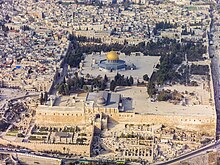Siege of Jerusalem (1244)
This article needs additional citations for verification. (July 2017) |
| Siege of Jerusalem | |||||||
|---|---|---|---|---|---|---|---|
| Part of the Crusades | |||||||
| |||||||
| Belligerents | |||||||
|
Khwarazmians |
| ||||||
| Commanders and leaders | |||||||
|
|
| ||||||
| Strength | |||||||
| Fewer | Unknown | ||||||
| Casualties and losses | |||||||
| unknown | 14,000 (disputed) | ||||||
| Part of a series on |
| Jerusalem |
|---|
 |
|
|
| Sieges |
| Places |
|
|
|
| Political status |
|
| Other topics |
|
The 1244 siege of Jerusalem took place after the Sixth Crusade, when roaming Khwarazmians clans conquered the city on July 15, 1244.[citation needed]
Prelude[]
Emperor Frederick II of the Holy Roman Empire led the Sixth Crusade from 1228 to 1229 and claimed the title of King of Jerusalem as the husband of Isabella II of Jerusalem, queen since 1212. The army brought by the emperor and his reputation in the Muslim world were enough to recover Jerusalem, Bethlehem, Nazareth and several strongholds without fighting, as signed by a treaty with the Ayyubid Sultan Al-Kamil. However, Jerusalem did not remain in the hands of Christians for long, as the latter did not control the surroundings of the city sufficiently to be able to ensure an effective defense.
Battle[]
In 1244, the Ayyubids allowed the Khwarazmians, whose empire was destroyed by the Mongols in 1231, to attack the city. The siege took place on 15 July, and the city fell rapidly. The Khwarazmians plundered it and left it in such a state of ruin that it became unusable for both Christians and Muslims. The sack of the city and the massacre which accompanied it encouraged the king of France Louis IX to organize the Seventh Crusade.
External links[]
- The Siege on Orthodox Wiki
- The Siege on Encyclopædia Britannica
- The Siege on Timeline:History of Jerusalem
- The Siege on The Jewish History Resource Center
- Conflicts in 1244
- 13th-century massacres
- Sieges of Jerusalem
- Military history of the Crusader states between the Sixth and Seventh Crusades
- Battles involving the Ayyubids
- Battles involving the Khwarazmian dynasty
- 1244 in Europe
- 1244 in Asia
- Sieges of the Crusades
- Massacres perpetrated by Muslims
- Massacres of Christians
- Razed cities
- 1240s in the Ayyubid Sultanate
- Siege stubs
- Middle Eastern history stubs